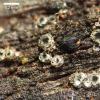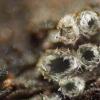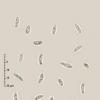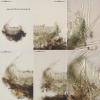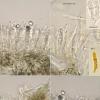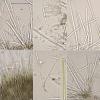
23-10-2024 17:27
Hi againThese tiny apothecia (100-200 µm) were gr

06-11-2024 20:07
• Macro and habitat suggest Hymenoscyphus s.l.,

04-09-2024 21:02
 Stephen Martin Mifsud
Stephen Martin Mifsud
I have found an interesting Xylaria growing on fal

06-11-2024 11:59
 Stephen Martin Mifsud
Stephen Martin Mifsud
I am trying to identify a Cheilymenia sp. using ke

05-11-2024 18:00
Karen PoulsenHello, Can anyone help with this one? On twigs o

05-11-2024 10:35
Juuso ÄikäsThese pale-yellow fruitbodies were growing on core

03-11-2024 17:36
• Macro and habitat suggest Hymenoscyphus s.l.,

04-11-2024 22:58
• Both Erysiphe and Phyllactinia species reporte

04-11-2024 20:28
A small group of Scutellinia found on a rotting lo
Hyalopeziza on Rhamnus
Enrique Rubio,
23-10-2024 17:27
These tiny apothecia (100-200 µm) were growing on wood of still attached branches of Rhamnus alpina at 1700 m altitude. I had not studied them until I was able to detect them with the bino three weeks after I had collected them.
Erumpent from the wood, with an olive-grey hymenium, asci without croziers, IKI-negative and spores without septa with a relatively high lipid content. The excipular hairs do not have solidifications nor septa, nor dextrinoid, but they do have walls up to 1 µm with a continuous lumen. Despite their conditions, the apos appear to have tolerated desiccation perfectly well.
The material agrees fairly well, except in some respects, with Raschle's description of Hyalopeziza nectrioidea, but less well with those of some other authors.What do you think?
Many thanks in advance
Hans-Otto Baral,
27-10-2024 07:52

Re : Hyalopeziza on Rhamnus
Dear Enrique
I can only agree, it is not H. nectrioidea but possibly close. The high lipid content in the spores I did not see in that species. But I was astonished about my collection with brown hairs HB 9906 which I first took for an Encoeliopsis but which was genetically clearly H. nectrioidea CBS 597.77 from Aletschwald.
Actually I so far only saw two collections in vivo, both with dark brown exterior (mine and that by Gernot). The type description is unclear in the spore contents and also in the ascus base.
Zotto
Adam Polhorský,
27-10-2024 09:57
Re : Hyalopeziza on Rhamnus
Hello Enrique, Zotto,
Personally I would think this is a Cordieri. and belongs to the "Macroskyttea" sambuci group.
Adam
Hans-Otto Baral,
27-10-2024 10:36

Re : Hyalopeziza on Rhamnus
Interesting idea! But can it be that it is unrelated to H. alni, which stands about between Hyaloscypha and Olla in my analysis?
Enrique Rubio,
27-10-2024 12:56
Re : Hyalopeziza on Rhamnus
Thank you both: Zotto and Adam.
Is there any clear morphological difference between Hyalopeziza and Macroskyttea?
Is there any clear morphological difference between Hyalopeziza and Macroskyttea?
Adam Polhorský,
27-10-2024 14:37
Re : Hyalopeziza on Rhamnus
H. alni is IKI+ right? Then it is likely that its unrelated. I can't speak much on Hyalopeziza, it is surely polyphyletic genus. And what is the type, H. patula or H.ciliata?
The "Macroskyttea" sambuci is also not a true Macroskyttea. Enrique, if you would like, I can try sequencing this collection, as we are starting to have a decent number of data from this group and so far each substrate has its own species.
Hans-Otto Baral,
27-10-2024 22:00

Re : Hyalopeziza on Rhamnus
My folders are two H. alni: one with amyloid ring (typical) and one with inamyloid asci.
I remember the type is not fully clarified.
Enrique Rubio,
28-10-2024 11:32
Re : Hyalopeziza on Rhamnus
Hi Adam
I have very few apos, only 5-6, so you can try it. If you were successful, both Zotto and myself would like to know the sequences. Send me your personal data so I can send you the material.
Thank you very mucho for your offer.
enrirubio@asturnatura.com
I have very few apos, only 5-6, so you can try it. If you were successful, both Zotto and myself would like to know the sequences. Send me your personal data so I can send you the material.
Thank you very mucho for your offer.
enrirubio@asturnatura.com
Hans-Otto Baral,
28-10-2024 12:15

Re : Hyalopeziza on Rhamnus
At the moment I am working on an MS about Echinula resinicola I am doing with Adam. In this conctext I saw your collection of an unidentified Echinula species on Vaccinium leaves (ERD-7984). It is from 28-VII-2019 but comprised only 4 apothecia based on the pics. Since so far no Echinula has been officially sequenced, this would make sense to compare with Adam's ITS sequence of E. resinicola. Of course, if anybody has a recent collection of an Echinula, this would be welcome as well (I see ERD 6173 from 24-IV-2014).
Adam Polhorský,
28-10-2024 12:47
Re : Hyalopeziza on Rhamnus
Thank you Enrique, I'll send you a PM. To preserve some material isolating from 3-4 apos is possible but not guaranteed to work, we can try.
Results I can ofc share, Zotto so far has all of my sequences. More samples are waiting to be processed.
Zotto, this summer I recollected E. resinicola, the sample is also in queue to be sequenced. Hopefully we can get DNA in a better quality. I tried to collect Echinula asteriadiformis for comparison, but was unsuccessful. So I would gladly take up good material of this species.
Results I can ofc share, Zotto so far has all of my sequences. More samples are waiting to be processed.
Zotto, this summer I recollected E. resinicola, the sample is also in queue to be sequenced. Hopefully we can get DNA in a better quality. I tried to collect Echinula asteriadiformis for comparison, but was unsuccessful. So I would gladly take up good material of this species.
Enrique Rubio,
28-10-2024 13:53
Re : Hyalopeziza on Rhamnus
The specimens of Echinula on Rubus and Vaccinium are now deposited in the herbarium of the Faculty of Biology of the University of León (Spain), because my University, the University of Oviedo, was not interested in keeping my collection of almost ten thousand specimens.
To request these fungi, you should write to its curator Estrella Alfaro. I am sure there will be no problem in getting them.
estrella.alfaro@unileon.es
The Hyalopeziza sample is in my possession. If you give me a shipping address I can do it myself.
To request these fungi, you should write to its curator Estrella Alfaro. I am sure there will be no problem in getting them.
estrella.alfaro@unileon.es
The Hyalopeziza sample is in my possession. If you give me a shipping address I can do it myself.
Adam Polhorský,
08-11-2024 12:41
Re : Hyalopeziza on Rhamnus
Hello Enrique, did you recieve my email with an address? It might have went to spam.
A.
